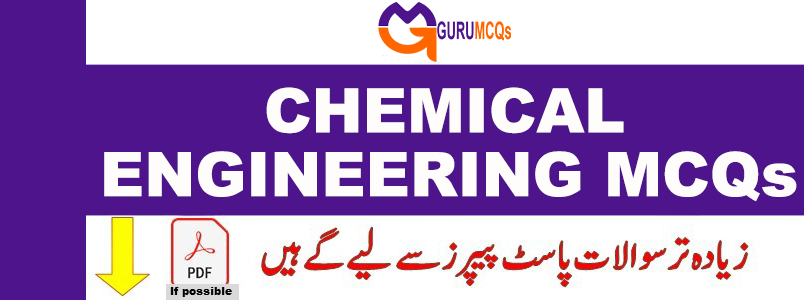
MCQs are considered among the most effective methods for assessing a student’s understanding of a concept. The www.gurumcqs.com team of subject experts has meticulously crafted these Chemical Engineering Questions and Answers MCQs, aligning them with current trends and industry practices. These MCQs in Chemical Engineering, along with detailed answers, comprehensively cover all facets of the discipline. Moreover, it will be beneficial for competitive examinations and tests (PPSC Test, FPSC Test, SPSC Test, KPPSC Test, BPSC Test) as well. The Chemical Engineering Questions and Answers encompass a wide range of topics, including Chemical Engineering Basics, Heat Transfer, Mass Transfer, Fertiliser Technology, Stoichiometry, Chemical Engineering Thermodynamics, Fuels and Combustion, Process Equipment and Plant Design, Nuclear Power Engineering, Refractory Technology, Polymer Technology, Fluid Mechanics, Mechanical Operations, Petroleum Refinery Engineering, Chemical Process, Process Control and Instrumentation, Chemical Reaction Engineering, Materials and Construction, Chemical Engineering Plant Economics, Furnace Technology, and Environmental Engineering. Additionally, explore Electrical Engineering Questions and Answers on the platform.
**71. What is the unit typically used to measure chemical energy?**
**A. Joules (J)**
B. Newtons (N)
C. Watts (W)
D. Volts (V)
**Answer: A. Joules (J)**
**72. Which of the following is an example of potential chemical energy?**
**A. A battery**
B. Running water
C. A moving car
D. Sunlight
**Answer: A. A battery**
**73. What type of energy is released when ATP (adenosine triphosphate) is hydrolyzed during cellular processes?**
**A. Chemical energy**
B. Mechanical energy
C. Thermal energy
D. Radiant energy
**Answer: A. Chemical energy**
**74. In which organelle does cellular respiration primarily occur in eukaryotic cells?**
A. Nucleus
B. Golgi apparatus
**C. Mitochondria**
D. Endoplasmic reticulum
**Answer: C. Mitochondria**
**75. Which of the following is NOT a form of chemical energy?**
A. Gasoline
B. Battery
**C. Wind**
D. Food
**Answer: C. Wind**
**76. Which type of energy is most directly responsible for holding atoms together in a molecule?**
A. Electrical energy
B. Mechanical energy
**C. Chemical energy**
D. Nuclear energy
**Answer: C. Chemical energy**
**77. When coal is burned in a power plant to generate electricity, what type of energy transformation occurs?**
**A. Chemical energy to electrical energy**
B. Electrical energy to mechanical energy
C. Mechanical energy to thermal energy
D. Radiant energy to chemical energy
**Answer: A. Chemical energy to electrical energy**
**78. What is the chemical formula for glucose, a molecule commonly used for energy storage in living organisms?**
**A. C6H12O6**
B. H2O
C. CO2
D. NaCl
**Answer: A. C6H12O6**
**79. Which of the following is an example of a renewable source of chemical energy?**
A. Coal
B. Natural gas
**C. Biomass**
D. Petroleum
**Answer: C. Biomass**
**80. What is the primary function of chemical energy in living organisms?**
A. To provide structural support
B. To facilitate communication between cells
**C. To drive metabolic processes**
D. To maintain body temperature
**Answer: C. To drive metabolic processes**
